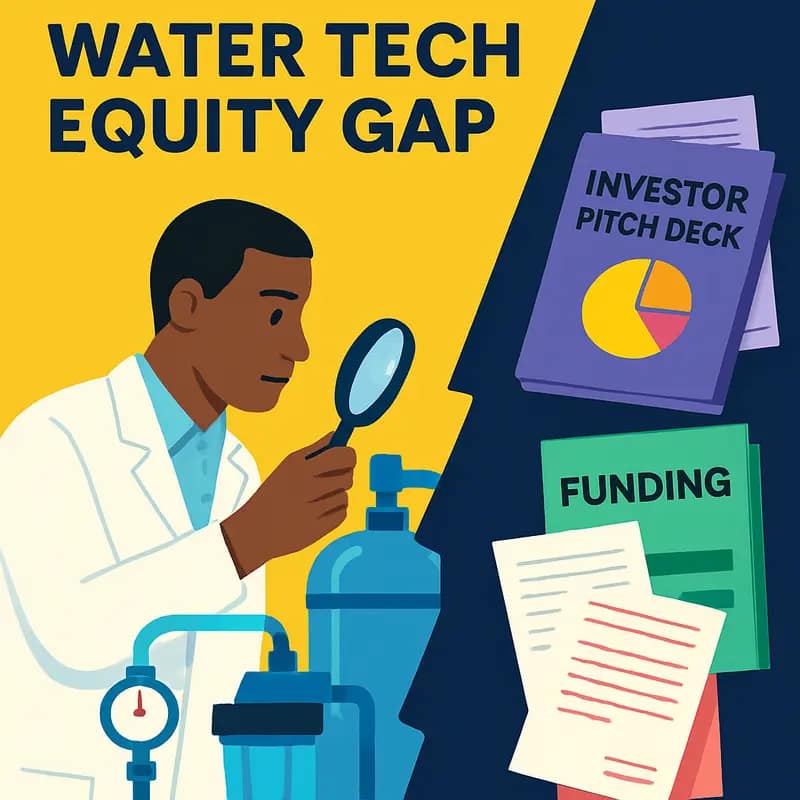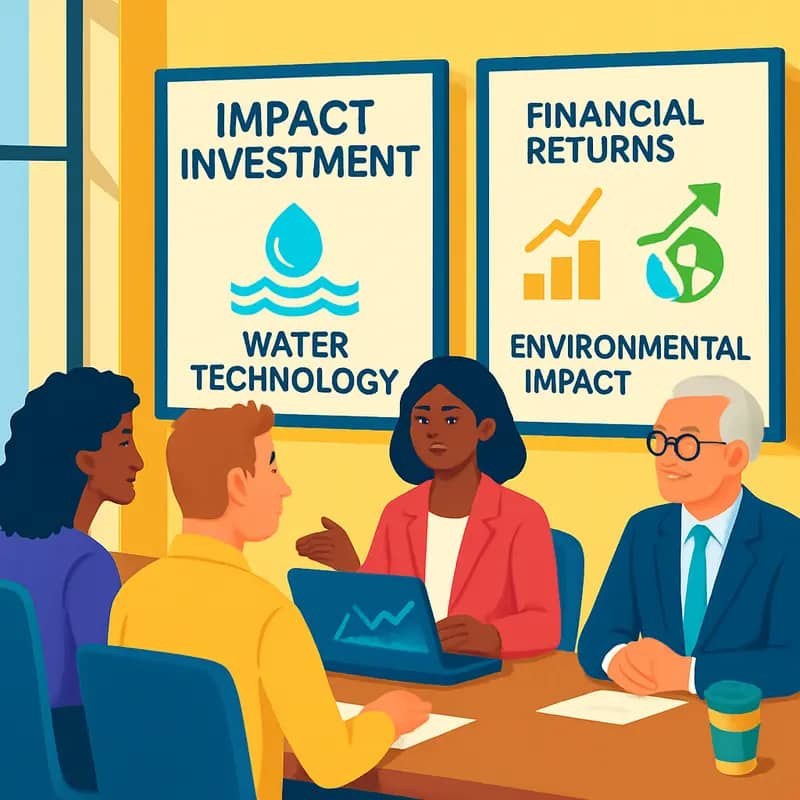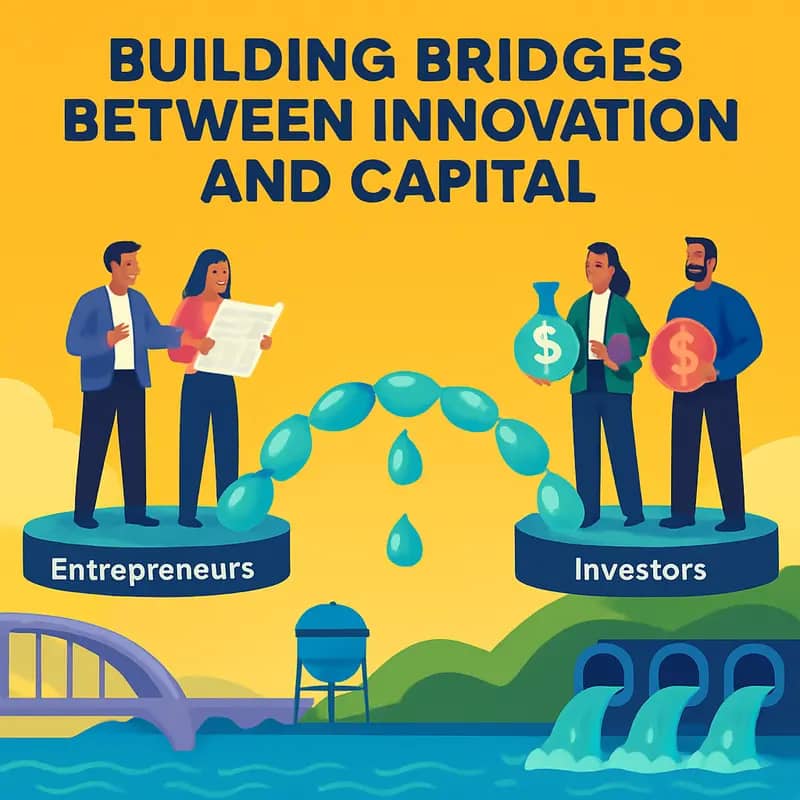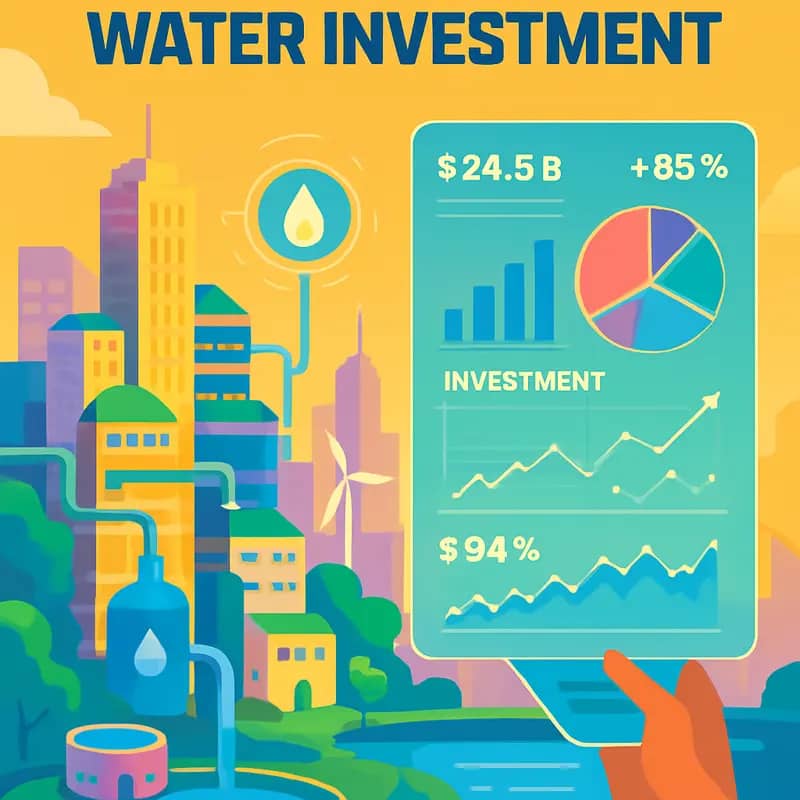The water technology sector stands at a critical juncture where breakthrough innovations meet pressing global challenges. Yet many promising water entrepreneurs face a persistent obstacle: the equity gap. This funding void between seed capital and Series A represents more than just a financial hurdle—it’s a crucial phase where groundbreaking solutions risk never reaching their full potential. For impact investors, this gap presents a unique opportunity to generate both meaningful returns and lasting environmental impact. By understanding the dynamics of water tech financing and the strategies for bridging this divide, we can unlock the next wave of water innovation.
Equity Gap is part of my Ultimate Water Investor Database, check it out!
Investor Name: Equity Gap
Investor Type: Family Office
Latest Fund Size: $ Million
Dry Powder Available: No
Typical Ticket Size: $250k – $1M
Investment Themes: PFAS, digital twins, decentralized water treatment
Investment History: $2595555.56 spent over 2 deals
Often Invests Along: Old College Capital, Scottish Enterprise
Already Invested In: MiAlgae
Leads or Follows:
Board Seat Appetite:
Key People:
Understanding the Water Tech Equity Gap

The water technology sector faces unique funding challenges that create a significant equity gap between innovative solutions and necessary capital. This disconnect stems from fundamental misalignments between traditional venture capital models and the realities of water innovation.
Water technology development cycles typically span 5-7 years from concept to commercial deployment – substantially longer than the 18-24 month timelines preferred by most venture investors. This extended timeline reflects the rigorous testing, regulatory compliance, and pilot demonstrations required to validate water technologies. Infrastructure dependencies further complicate matters, as most solutions must integrate with existing water and wastewater systems that can be decades old.
Risk perception among investors presents another major hurdle. Water technologies often require significant upfront capital for equipment, facilities, and regulatory approvals before generating revenue. The complexity of water chemistry and treatment processes also introduces technical risks that many investors struggle to evaluate. Without deep domain expertise, venture firms tend to view water tech as a “hard tech” play with unclear paths to commercialization.
Infrastructure linkages create additional complications around customer adoption cycles. Water utilities and industrial users typically move cautiously when implementing new technologies, requiring extensive validation before making purchasing decisions. This conservative approach, while prudent for protecting public health and environmental compliance, extends sales cycles well beyond what most venture-backed companies can sustain.
The misalignment between venture capital’s preference for rapid scaling and water innovation’s methodical progression creates a challenging funding environment. Early-stage water companies often find themselves caught in a “valley of death” – too capital-intensive for angel investors but too early-stage for project finance or infrastructure funds.
This gap is particularly acute for breakthrough technologies addressing critical challenges like water scarcity, contamination, and climate resilience. Many promising solutions struggle to secure sufficient funding to advance through pilot testing and commercial validation, despite their potential for significant environmental and social impact.
As explored in this examination of venture capital dynamics in water, the traditional VC model’s limitations highlight the need for alternative funding approaches better suited to water innovation timelines and risk profiles. Understanding these structural challenges is essential for developing new investment frameworks that can effectively support water technology development.
Impact Investment as a Bridge

Impact investors are emerging as crucial players in addressing the water technology funding gap, bringing a unique blend of patient capital and mission-driven objectives. These investors recognize that water innovations often require longer development cycles yet offer substantial environmental and social returns alongside financial gains.
Unlike traditional venture capital firms, impact investors evaluate opportunities through a dual lens of financial viability and environmental impact metrics. Their investment criteria typically encompass three core elements: measurable water conservation or quality improvements, scalable business models, and clear paths to profitability – even if on extended timelines. Learn more about mitigating water risk through impact investing.
The expected financial returns for impact investors in water technology generally range from 10-15% annually, lower than traditional VC expectations but balanced by verified environmental benefits. These might include gallons of water saved, contaminants removed, or communities served. This adjusted return profile allows impact investors to support critical early-stage development phases when technical risk remains high.
Impact investors employ innovative financing structures to bridge the equity gap. Revenue-based financing, where returns are tied to company performance rather than strict exit timelines, has gained traction. Some funds utilize blended finance approaches, combining philanthropic capital with commercial investment to reduce risk and catalyze additional funding.
These investors also bring valuable strategic support beyond capital. Many maintain extensive networks within utilities, municipalities, and regulatory bodies – critical relationships for water technology adoption. Their expertise in impact measurement helps portfolio companies develop robust environmental tracking systems, enhancing credibility with future investors and customers.
The sector is witnessing increased collaboration between impact investors and traditional financial institutions. Impact funds often take lead positions in early rounds, validating both technology and impact metrics. This creates a foundation for larger institutional investors to participate in later stages, establishing a funding continuum that supports water innovations from development through scale-up.
Some impact investors are pioneering wholesale market transformation approaches. Rather than focusing solely on individual companies, they work to address systemic barriers in the water sector. This includes supporting policy advocacy, developing industry standards for impact measurement, and fostering collaboration between stakeholders.
Building the Perfect Pitch

Successful water technology investment pitches strike a delicate balance between commercial viability and environmental impact. Drawing from conversations with leading impact investors and water entrepreneurs, a clear framework emerges for crafting compelling investment narratives that resonate with both traditional and impact-focused funders.
Start by articulating your solution’s unique value proposition through the lens of market pain points. Rather than leading with environmental metrics, demonstrate how your technology addresses critical operational or cost challenges within the water sector. For instance, highlight how reduced energy consumption translates to operational savings while simultaneously reducing carbon footprint.
Market validation forms the cornerstone of any successful pitch. Demonstrate clear evidence of customer interest through pilot projects, letters of intent, or early adopter testimonials. Quantify your addressable market by segmenting it into immediately accessible opportunities and longer-term expansion potential. Be prepared to defend your market size calculations with credible third-party data and bottom-up analysis.
Scalability narratives should focus on three key dimensions: technical, operational, and financial. Technical scalability encompasses manufacturing capabilities, supply chain considerations, and technology readiness levels. Operational scalability addresses your team’s capacity to execute, including key hires and strategic partnerships. Financial scalability demonstrates how additional capital will accelerate growth and create sustainable competitive advantages.
Impact metrics require the same rigor as financial projections. Develop a measurement framework that tracks both direct impacts (water saved, energy reduced, pollutants removed) and indirect benefits (community health improvements, ecosystem restoration). Wherever possible, translate environmental impacts into monetary terms to help investors understand the full value proposition.
Financial returns must be realistic and well-supported. Present clear unit economics, showing how your solution delivers value at both pilot and commercial scale. Include sensitivity analyses demonstrating resilience to various market conditions. Early-stage ventures should focus on near-term milestones that de-risk the investment while building toward longer-term growth targets.
Finally, craft a compelling narrative that weaves these elements together. Your pitch should tell a story of transformation – how your solution turns water challenges into opportunities for both financial returns and environmental impact. Support this narrative with clear visuals, customer testimonials, and tangible proof points that demonstrate market traction and execution capability.
Remember that different investors have varying priorities. Be prepared to emphasize different aspects of your pitch depending on the audience while maintaining a consistent core message about your value proposition and impact potential.
Scaling Success Stories

In an industry often characterized by lengthy sales cycles and risk-averse investors, several water technology companies have successfully bridged the equity gap through innovative funding approaches and strategic partnerships. Their journeys offer valuable insights for emerging water entrepreneurs seeking to scale their solutions.
A particularly instructive example comes from a wastewater treatment innovator that leveraged a hybrid funding model combining traditional venture capital with strategic corporate partnerships. By securing early pilot projects with municipal utilities while simultaneously developing commercial applications, they created multiple revenue streams that attracted diverse investors. The company’s key insight was recognizing that different funding sources could support different stages of growth – grant funding for initial R&D, angel investors for prototype development, and institutional capital for scaling operations.
Another breakthrough case emerged from the water quality monitoring sector, where a startup employed a “land and expand” strategy with industrial customers. Rather than pursuing large-scale deployment immediately, they initiated small pilot projects with minimal upfront costs. The reduced risk threshold made it easier for customers to commit while providing crucial validation data for investors. This company raised over $10 million through three funding rounds by demonstrating consistent revenue growth and customer expansion.
Partnerships proved essential across these success stories. One water filtration company accelerated market entry by collaborating with established equipment manufacturers, gaining credibility and distribution channels. Their partnership strategy focused on complementary capabilities – combining their novel technology with partners’ market access and manufacturing expertise. This approach helped them achieve rapid commercial adoption while maintaining capital efficiency.
Several common themes emerge from these examples. First, successful companies typically developed multiple paths to market rather than focusing solely on a single customer segment or application. This diversification reduced risk for investors while creating more opportunities for growth. Second, they prioritized early demonstration projects and pilot installations, even if initially unprofitable, to generate performance data and customer testimonials. Third, they structured deals to align incentives between investors, partners, and customers – often using creative approaches like revenue sharing or performance-based pricing.
Perhaps most importantly, these companies maintained unwavering focus on solving clearly defined customer problems while remaining flexible in their paths to market. Rather than rigidly adhering to initial business plans, they adapted their strategies based on market feedback while staying true to their core value proposition. This balance between persistence and adaptability proved crucial for scaling successfully in the complex water technology landscape.
Lessons from these journeys underscore that bridging the equity gap requires more than just innovative technology – it demands careful orchestration of funding sources, partnerships, and go-to-market strategies. For water entrepreneurs following in their footsteps, these examples provide a valuable roadmap while highlighting the importance of crafting strategies tailored to their unique circumstances.
Understanding the Water Innovation Funding Desert

The water technology sector faces a paradoxical funding challenge. Despite water being essential for life and economic development, early-stage water innovators struggle to secure adequate investment capital, creating a stark equity gap in the industry.
Recent data reveals that water technology ventures receive less than 1% of total venture capital funding globally. This funding desert persists even as the global water crisis intensifies and innovative solutions become increasingly critical. According to recent analyses, while climate tech overall attracted over $70 billion in venture funding in 2022, water-focused startups received only around $470 million.
Several factors contribute to investors’ hesitation in backing water ventures. The water sector’s regulatory complexity creates long commercialization timelines that clash with traditional venture capital models seeking rapid returns. Additionally, the fragmented nature of the water market, dominated by risk-averse municipal utilities, makes scaling challenging for startups.
Investors also struggle with the sector’s capital intensity. Water infrastructure projects often require significant upfront investment in physical assets, contrasting sharply with the capital-light software startups that dominate venture portfolios. The typical 7-10 year exit timeline for water technology companies extends beyond most venture funds’ investment horizons.
Perhaps most significantly, water’s status as a public good creates pricing challenges that impact potential returns. While water tech can deliver tremendous social and environmental impact, monetizing these benefits within existing market structures proves difficult. The artificially low price of water in many regions further complicates the revenue models of innovative solutions.
This systemic underinvestment creates a challenging cycle. Without adequate early-stage funding, promising water technologies struggle to reach commercial scale. This lack of successful examples then reinforces investor skepticism about the sector’s potential returns. The result is a persistent innovation gap at a time when water challenges demand transformative solutions.
However, growing water stress and evolving market structures are beginning to shift this dynamic. Impact investors increasingly recognize water technology’s potential to deliver both environmental benefits and financial returns. New financing mechanisms, from blended capital to water-specific venture funds, are emerging to bridge the equity gap.
Understood properly, the current funding desert represents both a challenge and an opportunity. For investors willing to take a longer view and structure deals appropriately, water technology offers a chance to generate returns while addressing one of humanity’s most pressing challenges. For innovators, success requires not just technological excellence but creative approaches to funding and commercialization that align with the sector’s unique characteristics.
The Hidden Value in Water Technology

The path from innovative water solution to successful venture often appears impossibly steep, yet several trailblazing companies have demonstrated that proper funding can dramatically accelerate market adoption and impact. Their stories reveal key patterns for bridging the equity gap in water technology.
Consider a pioneering water reuse venture that struggled initially to secure traditional financing despite proven technology. By quantifying their solution’s triple bottom line impact – 40% reduction in industrial water consumption, 50% decrease in wastewater discharge costs, and 30% energy savings – they attracted impact investors aligned with both financial returns and sustainability goals. This funding enabled rapid scaling from pilot to commercial deployment across multiple industrial sites within 18 months.
Another instructive case comes from the municipal sector, where a smart water analytics company faced skepticism about their AI-driven approach to infrastructure management. Rather than pursuing conventional venture capital, they structured an innovative pay-for-performance model with their first utility customer. The demonstrated results – reducing non-revenue water losses by 25% and operating costs by $2 million annually – helped secure a strategic investment round that fueled expansion to 50+ utilities.
These success stories highlight how proper funding acts as a catalyst in multiple ways. First, it enables critical pilot demonstrations that build market confidence. Second, it supports development of sales and implementation capabilities needed for commercial scale. Third, it provides runway to refine business models and prove unit economics.
Perhaps most importantly, well-structured funding helps water technology companies weather the typically longer adoption cycles in this sector. While software startups may see hockey stick growth in months, water ventures often need 2-3 years to move from pilot to widespread deployment. Patient capital that understands this dynamic is essential.
The key metrics that resonated with successful water tech investors combine conventional financial returns with concrete impact measures: gallons of water saved or cleaned, energy reduction achieved, infrastructure life extended, and communities served. By articulating value through both lenses, companies can engage a broader pool of capital sources beyond traditional VCs – from impact funds to family offices to strategic industry players.
As discussed in How to actively invest philanthropy and save the water world, innovative funding approaches are emerging that blend different capital types to match the unique needs of water ventures. This “funding innovation” may prove as important as technological innovation in accelerating solutions to global water challenges.
Building Bridges Between Innovation and Capital

The water technology sector presents unique challenges for connecting innovators with capital. While water solutions offer tremendous potential for both financial returns and environmental impact, traditional investment frameworks often struggle to properly value these opportunities.
Successful water ventures require a nuanced approach to positioning their innovations. Rather than focusing solely on technical specifications, entrepreneurs must craft compelling narratives that highlight clear paths to revenue and scalability. This means quantifying both direct financial benefits and broader societal impact metrics like water savings, energy reduction, and improved public health outcomes.
A critical element is demonstrating deep market understanding and customer validation. Water technology buyers tend to be risk-averse, making pilot projects and reference customers essential for building credibility. Entrepreneurs should document their pilot results rigorously, focusing on metrics that matter most to potential customers and investors – implementation costs, operational savings, and maintenance requirements.
For investors, water technology requires adjusting traditional venture capital expectations around growth trajectories and exit timelines. The sector’s longer sales cycles and complex regulatory environment mean that promising solutions may take 5-7 years to achieve meaningful market penetration. However, as discussed in depth at A Deep Dive into How Water Tech Investment Works, patient capital approaches that account for these dynamics can unlock exceptional returns while driving crucial innovation.
Bridging the gap requires both sides to embrace new models of collaboration. Accelerator programs, technology validation partnerships, and blended capital approaches combining grants, venture funding and strategic investment can help de-risk early-stage water innovations. Corporate strategic investors and family offices focused on water impact are emerging as key players in providing the patient capital these ventures need.
Water entrepreneurs must also think creatively about business model innovation. Service-based approaches, creative financing structures, and strategic partnerships can help overcome adoption barriers. Rather than selling technology alone, successful ventures increasingly offer comprehensive solutions that address customers’ operational, financial and regulatory needs.
Ultimately, bridging the innovation-capital gap in water technology requires an ecosystem approach. Industry consortiums, policy frameworks supporting innovation adoption, and platforms connecting entrepreneurs with aligned investors all play vital roles. By working together to develop new frameworks that properly value both financial and impact returns, we can accelerate the deployment of crucial water solutions.
Catalyzing the Future of Water Investment

The water technology investment landscape is undergoing a profound transformation as innovative funding models emerge to address the sector’s unique challenges. Blended finance structures are gaining prominence, combining philanthropic capital with commercial investment to de-risk early-stage water innovations. These hybrid approaches help bridge the valley of death that many water startups face between pilot demonstrations and commercial scale.
A new wave of investment vehicles is emerging that specifically caters to water technology’s longer development cycles and capital-intensive nature. Revenue-based financing allows companies to repay investments through a percentage of future earnings rather than giving up equity. This model particularly suits water technology firms with predictable revenue streams from municipal contracts or industrial customers.
Partnership approaches are evolving beyond traditional venture capital relationships. Technology validation partnerships between startups and established water companies are becoming critical stepping stones for commercialization. These collaborations provide startups with real-world testing environments while giving larger firms early access to promising innovations.
Measuring and communicating impact has become increasingly sophisticated. Investors now evaluate water technologies through multiple lenses – from quantifiable metrics like gallons saved or contaminants removed to broader environmental and social benefits. Advanced modeling tools help projects demonstrate both their sustainability impact and financial returns, speaking the language of both impact and traditional investors.
Digital platforms are streamlining connections between water innovators and capital sources. Online investment marketplaces specific to water technology help match startups with relevant investors while standardizing due diligence processes. This democratization of access helps promising solutions find backing regardless of their geographic location.
Perhaps most significantly, the water sector is seeing the emergence of specialized accelerators and incubators that combine capital with deep domain expertise. These programs provide crucial technical validation, market access support, and connections to follow-on investment – addressing the sector’s historical challenges around technology risk assessment and commercialization pathways.
As these new models mature, they’re creating more efficient pathways for water innovation to scale. The key is maintaining flexibility – different solutions require different funding approaches at various stages of development. Success lies in matching the right capital structure to each opportunity while keeping focus on measurable impact alongside financial returns.
Final words
The equity gap in water technology represents both a challenge and an opportunity for the sector. While traditional funding models may struggle to accommodate water innovation’s unique characteristics, the rise of impact investing and growing awareness of water challenges are creating new pathways for bridging this divide. Success lies in understanding both sides of the equation – entrepreneurs must adapt their approach to address investor concerns while maintaining their innovative edge, and investors need to recognize the distinctive value proposition of water technology investments. The future of water innovation depends on our ability to bridge this gap effectively, combining patient capital with transformative technology to create sustainable solutions for global water challenges.
Wanna explore the Full List of Water Investors that cut at least two checks over the past decade? Check it out and bookmark it, I update it regularly!
Learn more: https://dww.show/the-ultimate-water-investor-database/
About us
Through my ‘(don’t) Waste Water’ platform, I offer unique and insightful coverage of the water industry that combines technical expertise with engaging storytelling. If you haven’t yet, it might be time for you to subscribe to the podcast, the youtube channel and/or the newsletter!
